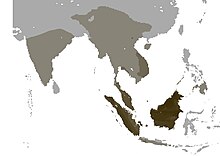
Back Boomspitsmuis Afrikaans زبابيات الشجر Arabic زبابيات الشجر ARZ Scandentia AST Tenecoldunol (Scandentia) AVK سکاندنتیا AZB Semal BAN Вавёрачнікі BE-X-OLD Тупайоподобни Bulgarian Tupai BJN
| Treeshrews[1] Temporal range: Middle Eocene – Recent
| |
|---|---|

| |
| Tupaia sp. | |
| Scientific classification | |
| Domain: | Eukaryota |
| Kingdom: | Animalia |
| Phylum: | Chordata |
| Class: | Mammalia |
| Grandorder: | Euarchonta |
| Order: | Scandentia Wagner, 1855 |
| Families | |

| |
| Red: Tupaiidae, blue: Ptilocercidae, purple: both Tupaiidae and Ptilocercidae | |

| |
| The distribution and density of treeshrew species. | |
The treeshrews (also called tree shrews or banxrings[3]) are small mammals native to the tropical forests of South and Southeast Asia. They make up the entire order Scandentia (from Latin scandere, "to climb"),[4] which split into two families: the Tupaiidae (19 species, "ordinary" treeshrews), and the Ptilocercidae (one species, the pen-tailed treeshrew).
Though called 'treeshrews', and despite having previously been classified in Insectivora, they are not true shrews, and not all species live in trees. They are omnivores; among other things, treeshrews eat fruit. As fellow members of Euarchonta, treeshrews are closely related to primates, and have been used as an alternative to primates in experimental studies of myopia, psychosocial stress, and hepatitis.[5]
- ^ Helgen, K.M. (2005). "Order Scandentia". In Wilson, D.E.; Reeder, D.M (eds.). Mammal Species of the World: A Taxonomic and Geographic Reference (3rd ed.). Johns Hopkins University Press. pp. 104–109. ISBN 978-0-8018-8221-0. OCLC 62265494.
- ^ "Appendices | CITES". cites.org. Retrieved 2022-01-14.
- ^ Rines, George Edwin, ed. (1920). . Encyclopedia Americana.
- ^ Martin, Robert E.; Pine, Robert H.; DeBlase, Anthony F. (2011). A Manual of Mammalogy with Keys to Families of the World, Third Edition. Waveland Press. p. 94. ISBN 978-1-47860-953-7. Retrieved 16 December 2024.
- ^ Cao, J.; Yang, E.B.; Su, J.-J.; Li, Y.; Chow, P. (2003). "The tree shrews: Adjuncts and alternatives to primates as models for biomedical research" (PDF). Journal of Medical Primatology. 32 (3): 123–130. doi:10.1034/j.1600-0684.2003.00022.x. PMID 12823622. S2CID 16910445. Retrieved 1 January 2012.